Knights and chivalry of three centuries. Knights of Ireland (part 4)
charmer, folded,
blade steel is my trusty knife
cling to me like a wife.
(“Steel-girlfriend.” Miredah O'Dhali nicknamed Scot (d. Ok. 1224))
If there is any country in Europe whose past is more shrouded in mystery than the others, then this will no doubt be Ireland - the last island on the edge of the inhabited land in antiquity. The Romans did not go there, but people during the time of their rule over England already lived there. According to the medieval Christian "Book of the Seizure of Ireland", it was conquered by the Spanish Celts sailing from Galicia, called the Milesians (from the legendary Spanish Mile). "History Britons ”(IX c.) They are also mentioned and informed that the father of the Irish Gauls is precisely this Mil. Archaeological evidence of this invasion by the Spaniards in Ireland does not exist, but this legend is still alive today.
Irish warriors fight the Vikings in the Battle of Clontarf (23 on April 1014). Fig. Angus McBride
Well, according to the data of modern science, 84% of male Irish have a genetic marker for the haplogroup R1b, although the first settlers who arrived on the island around 4350 BC. e., had a marker of the haplogroup "G". The music was then almost 2500 years ago, people with this group were almost destroyed, so today it is found only in 1% Irish men. And R1b is widely present in northern Spain and also in southwest France.
On the other hand, such an arrangement in Ireland was beneficial for her. It was not so easy to get there to conquerors. That is why, when in V c. Christianity spread on the island, it became a kind of “reserve of peace and tranquility”, which contributed to the flourishing of early Christian culture and the center of Western scholarship. The main role on the island was played by clans headed by their leaders, which was caused by the poverty of resources, which did not allow too many nonworking parasites in the community. The situation was complicated only in the tenth century, when Scandinavian Vikings began to make raids on Ireland. However, in 1014, the Irish King Briand Bor managed to defeat them at the Battle of Clontarf. However, he himself died and a series of bloody strife began on the island. Interestingly, right up to the Anglo-Norman invasion, Ireland was divided into five kingdoms, and there was no unified state in it. When, after 1175, the British dominion was finally established in Ireland (even if not everywhere), the Irish, using different cases - either victories of Robert the Bruce, or the plague epidemic of 1348, which mowed all the English in the cities, tried to free themselves from it, at the time they failed. By the way, it is interesting that, although Ireland is smaller than England, more than 100 castles (in England there are only 40) survived on its lands, and since there is a castle, then surely the castle had a suzerain, and warriors who had to protect him.
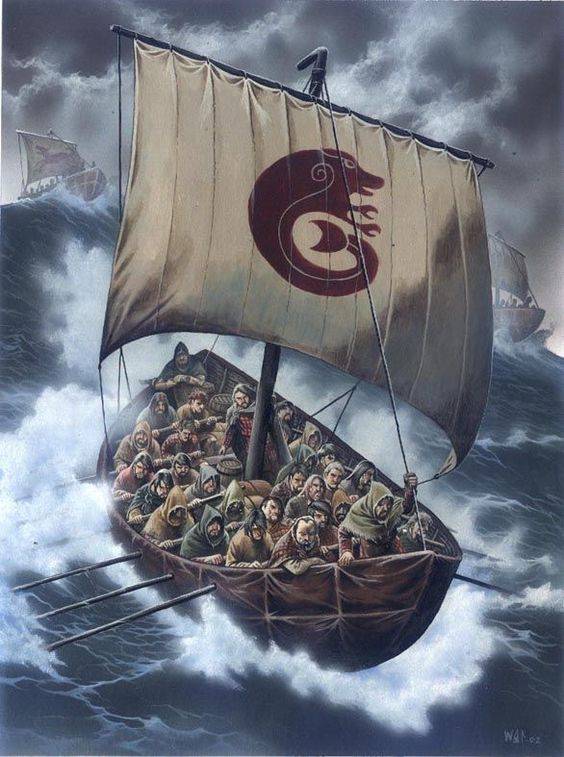
Currach - sailing boat of the ancient Irish and the Picts with leather trim. It is believed that it was on this boat that St. Brendan made his voyage to Iceland, to the Faroes and to America. Fig. Vine Reynolds.
For many centuries, the basis of the Irish armed formations for natural reasons were fairly lightly armed infantrymen, who had in their arsenal a sword, a long dagger, a bow with arrows and a set of darts for throwing. The reason for so meager, in principle, weapons was that the main type of inter-clan "wars" were forays to steal livestock.
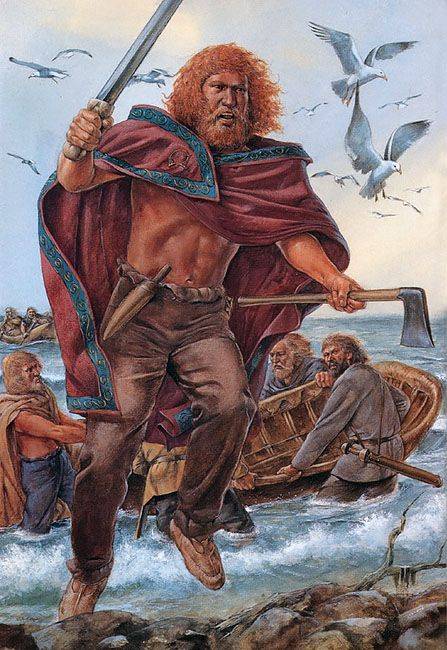
Ancient Irishman during a raid on the coast of Britain, V in. Such raids for the sake of production and demonstration of their youth were in the habit of many nations. Fig. Richard Hook.
At the same time, the Irish Gaelians began to learn a lot from the Scandinavians and widely use battle axes on long shafts. The English historian Ian Heath, for example, reports that the Irish and their axes (previously adopted under Scandinavian influence) became so inseparable that they carried them everywhere, even in peacetime. Girald Cambrinsky "Topography of Ireland" (approx. 1188) wrote that the ax was held in only one hand, "pulling the thumb along the handle to direct the blow"; and adds that neither the helmet nor the chain mail would protect against impact weapons. Although one Anglo-Norman knight and managed to escape from the Irish ambush, although his horse received three blows with such an ax, and he himself - two in his shield. Another weapon of ordinary warriors, called cores, was a short spear and two darts. The sling was also used, because of something, and there were enough stones in Ireland even in abundance. Long daggers in the sources are more common than swords, and shields are mentioned very rarely. Short, light darts could not penetrate the armor and more often wounded than killed, besides the Irish did not use the bow at first, therefore their “fire power” was limited. However, in the "Conquest of Ireland" from 1189, the same Girald notes that after the Anglo-Norman invasion the Irish "... gradually became adept and well-versed in handling arrows." Although the Irish archers were first told in the Annals of Ulster, in 1243 year. However, oddly enough, the Irish bow was not a Welsh long bow, but was a short weapon, which in the XIII century. in England they called it "half a hat". One of these bows, made from a yew length of about 35 inches, and with a handle slightly offset from the center, was found in Desmond Castle as early as the late 19th century. It is known that such bows were used by Irish soldiers even in the 17th century. By the way, where the Vikings settled, for example, in eastern Ireland, the bow was used more widely.
Viking weapons in the National Museum of Ireland in Dublin.
According to Giralda’s “Topography of Ireland”, the clothes of the Irish warrior consisted of soft shoes, a linen tunic, tightly fitting woolen pants (in winter, summer went with bare legs) and a caftan, often quilted, with a tight hood. A very important part of the wardrobe was a raincoat - bre, which spoke about the status of its owner. Well, the poor, he often was made from a quilt.
The clothes were mostly black (most Irish sheep apparently were black at the time). However, from earlier sources, we know that the Irish liked bright colors, and there is no reason to suppose that their tastes changed afterwards. The illustrations of the Giralda show clothing mainly in light shades of green, brown, red and gray, sometimes striped fabrics are used.
The image of the gallowglass warriors on the side of the Felim O'Connor sarcophagus (Roscommon Abbey, Ireland)
Even in the 1260 year, they often engaged in a single shirt, which in Gaelic was called Lane and possibly had a hood. On the other hand, 1300's poem dedicated to King Connacht Aed O'Conor (1293-1309) describes his equipment, which included a helmet, akaton (kotun), and a shell corset (lauirech), under which he had just was wearing a hooded shirt. He had golden spurs on his feet, and a weapon, a sword, a spear and a shield (sgiaf) of white color, decorated with "dragons and golden branches". That is, his armament was already quite knightly.
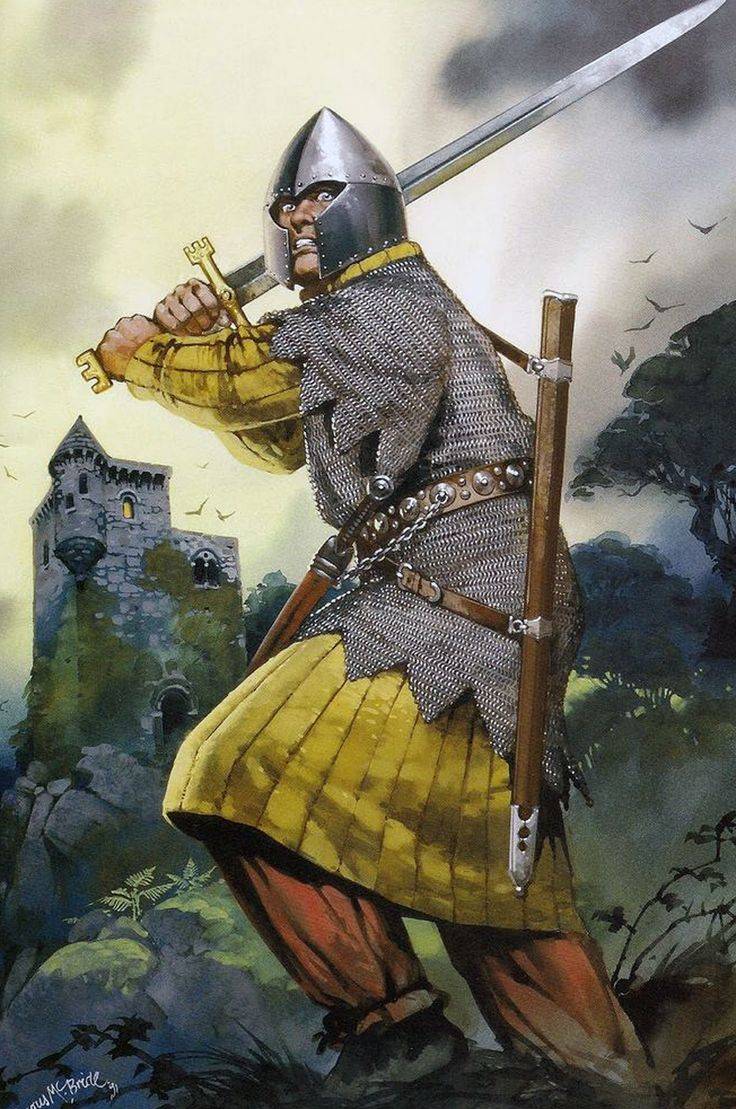
Warrior galloglas Fig. Angus McBride
And now we will pay attention to one important and interesting circumstance. Ireland, like Norway and Sweden, was poor in food resources. Here it was good to breed sheep that gave wool, but you need to imagine how much hay they needed to stock up for the winter, and that was on local rocky pastures. No wonder it was in Ireland that the breed of horses of the connemara-pony, short, furry, unpretentious was bred. These were good horses on the farm and for riding, but they were completely unsuitable as knightly horses.
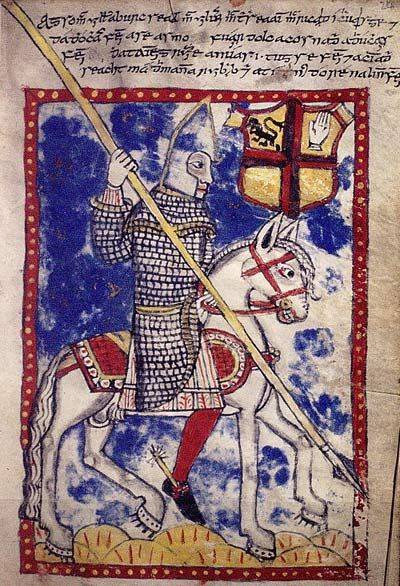
Irish rider. A miniature from the Book de Burgo manuscript (“History and genealogy of the de Burgo family”), although it was written in the 16th century. And directly with the time frame of this topic, it seems, is not connected. But looking at his armor, no longer doubt their archaism. (Trinity College Library, Dublin)
In the end, all this led to ... mass emigration, first Scandinavians, and then Irish Gaelians, and in the first, and in the second case, in the search for happiness, male warriors left the house, becoming either Vikings or mercenaries, who were called Galloglas (Gael. Gallóglach, letters. "foreign warrior"). They served in the armies of the Irish landlords from the Gaelic clans of the Western Isles and the Scottish highlands and in the XIII-XVII centuries were a real elite. Over time, however, they mingled with the Norwegian settlers in both Ireland and Scotland, as well as the Picts, and now the Irish themselves called them none other than Gall Gaeil (literally “foreign gels”).
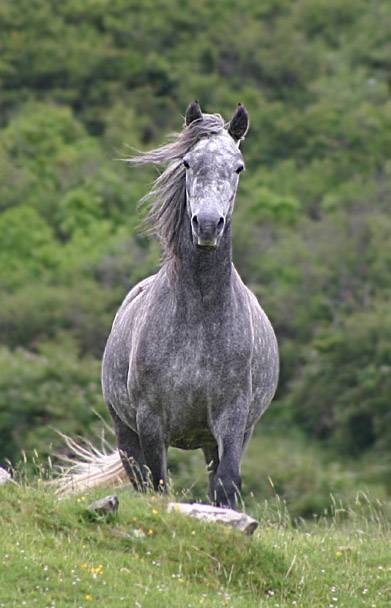
Connemara ponies were ideal for light horse riders who fought in the mountainous regions of Ireland.
They are first mentioned in the Irish chronicles relating to the 1259 year, when the king of Connacht received a dowry from the daughter of the King of Hybrids 160 Scottish warriors. In exchange for military service, the Galloglass received land and settled in the possession of the Irish leaders, where they were given the right to feed at the expense of the local population. In their armament galloglazes belonged to the heavily armed infantry. Their main weapon was a massive two-handed ax, which had a clearly Scandinavian origin, as well as a two-handed sword-claymore and sometimes a spear. As a rule, they wore chain mail worn over soft quilted gambizon and iron helmets of the simplest styles. In the battle, galloglas was accompanied by two young men who served as his assistants: one carried throwing spears, while the other had a supply of provisions. But they, too, had spears and bows, and also in some cases could participate in combat. It is noted that due to its heavy weapons and, in particular, long-field mail, gallows were not as mobile as riders mounted on a horse-rider-pony and Irish lightly armed core warriors. But they usually fought well in defense. Interestingly, as mercenaries, they often settled on the land and then enjoyed the same rights as the indigenous Irish.
Guerrilla warfare tactics turned out to be the most effective form of defense against the attacks of the Normans and the Irish, and here the traditional Irish weapons, such as darts and slings, and later the bow, were very effective. “A miniature from the manuscript“ Roman about Alexander ”, 1250, Abbey Art. Alban, England. (University of Cambridge Library)
At the end of the XIII century, the local Norman-Irish equestrian elite went into decline because there was simply no one to fight on the island. Later, a unique tactic was developed here, based on the interaction of light cavalry, supported by archers or throwers of darts - cores. And they, in turn, were supported by the elite infantry of the gallows, which is excellent in its two-handed axes, as well as the two-handed swords. The latter indicates that the Scottish military influence continued to play an important role in Ireland both at the beginning of the 14th century and subsequently. What point, by the way, and the work of Dürer. Well, well-known Irish horseback riders, who belonged to light cavalry, served in Scotland and England in the 14th century and, finally, even in France, which speaks best of their effectiveness.
Irish Mercenaries 1521 d. Figure by Albrecht Dürer. Obviously, despite the fact that between 1350 and 1521. The term is quite considerable, the appearance of the Irish warriors during this time has not changed at all.
With regard to the national characteristics of the Irish weapons should be attributed perhaps ... an unusual and nowhere else occurring pommel of the sword. It had the form of a ring through which it was possible to see its shank, flattened on the outer rim of this ring. Crossings were also unusual and had horizontal S-shaped blades, flattened at the ends in the form of blades. The length of such swords was 80 cm, but two-handed swords and bastard swords are also known.
Modern reconstruction of a typical Irish sword.
Использованная литература:
1. Oakeshott, RE Sword in the Age of Chivalry, London, revised edn., London etc., 1981.
2. Dufty, AR and Borg, A. European Swords and Daggers in London, London, 1974.
3. Clements, J. Medieval Swordsmanship. Illustrated Methods and Techniques. USA. Paladin Press, 1998.
4. Nicolle, D. Arms and Armor of the Crusading Era, 1050 - 1350. UK L .: Greenhill Books. Vol.1.
5. Braniff, S.A. Galloglass 1250 – 1600. Gaelic Mercenary Warrior. Oxford, Osprey Publishing (WARRIOR 143), 2010.
6. Gravette, K., Nicole, D. Normans. Knights and Conquerors (Transl. From English A.Kolina) M .: Eksmo, 2007.
7. Gravette, K. Knights: The History of English Knighthood 1200-1600 / Christopher Gravette (Translated from English by A. Colin). M .: Eksmo, 2010.
8. Leible, Thomas. Sword. Great illustrated encyclopedia. / trans. with him. / M .: Omega, 2011.
To be continued ...
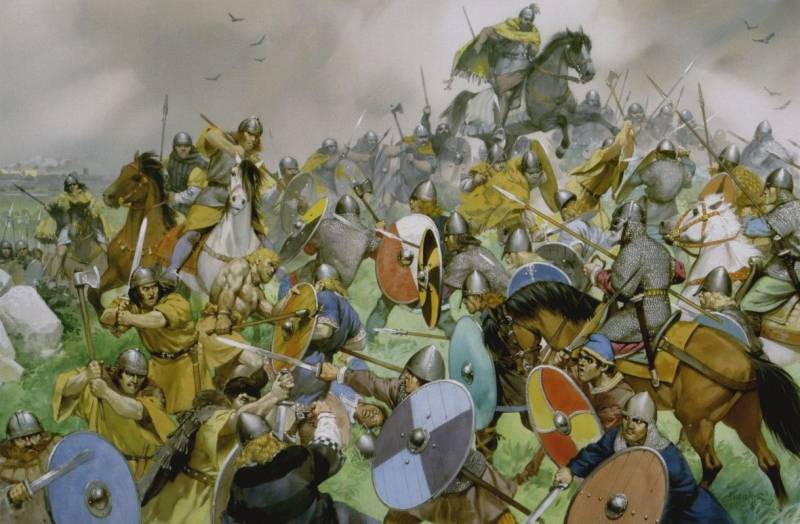
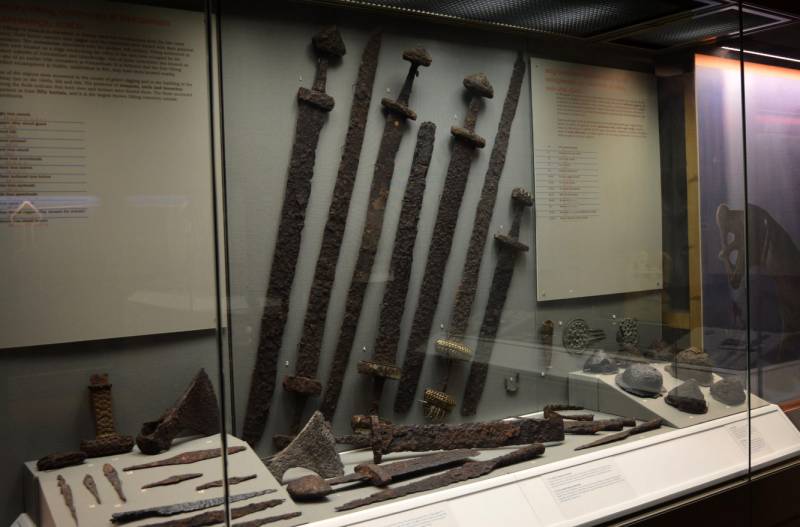
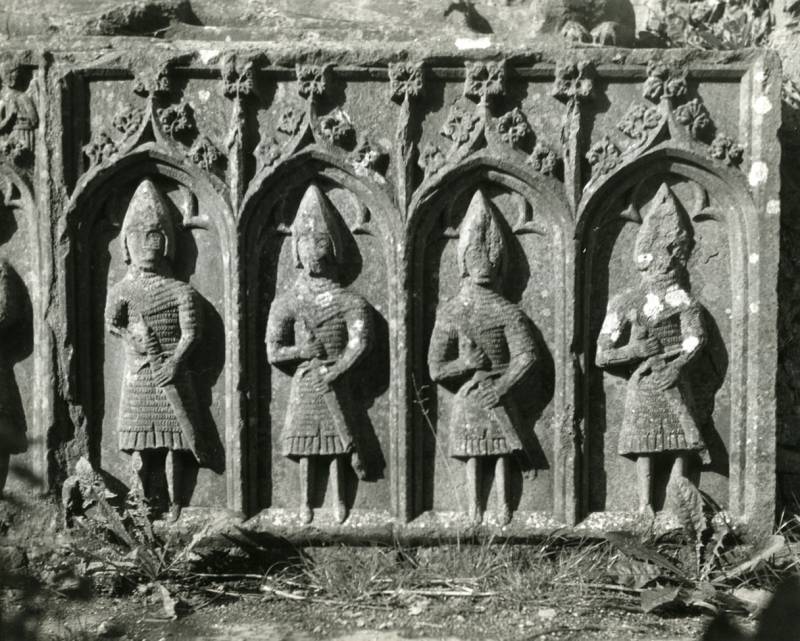
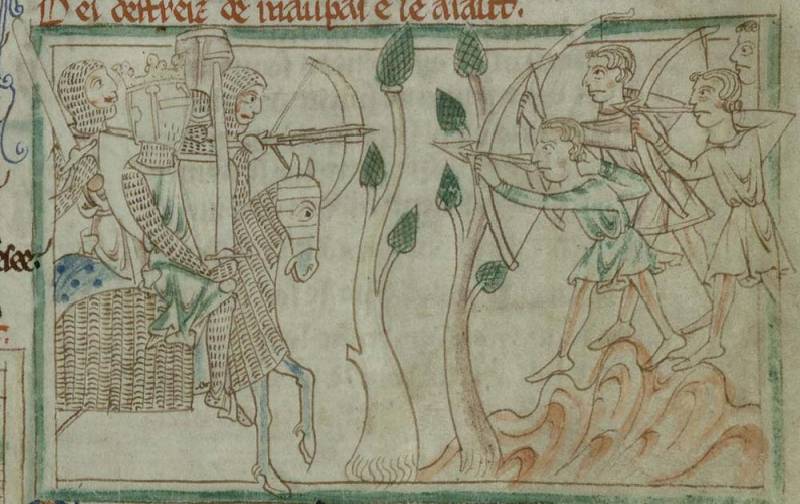
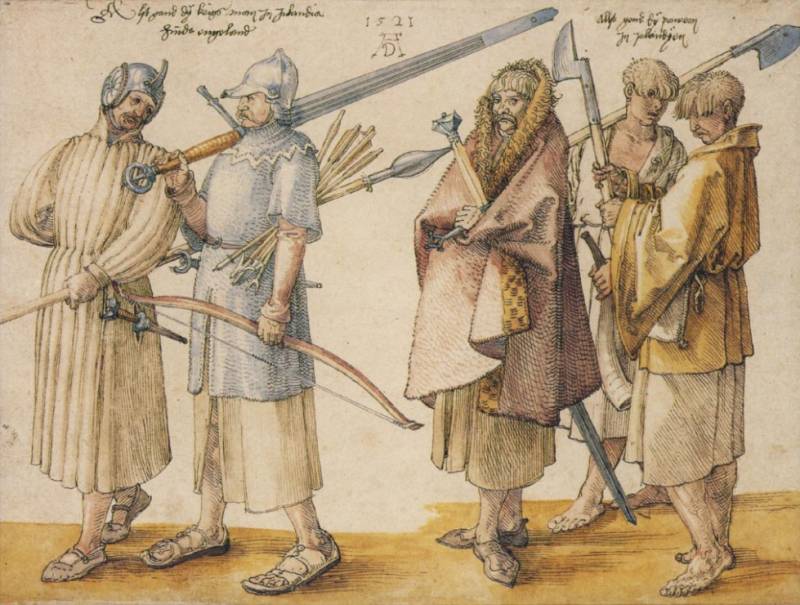
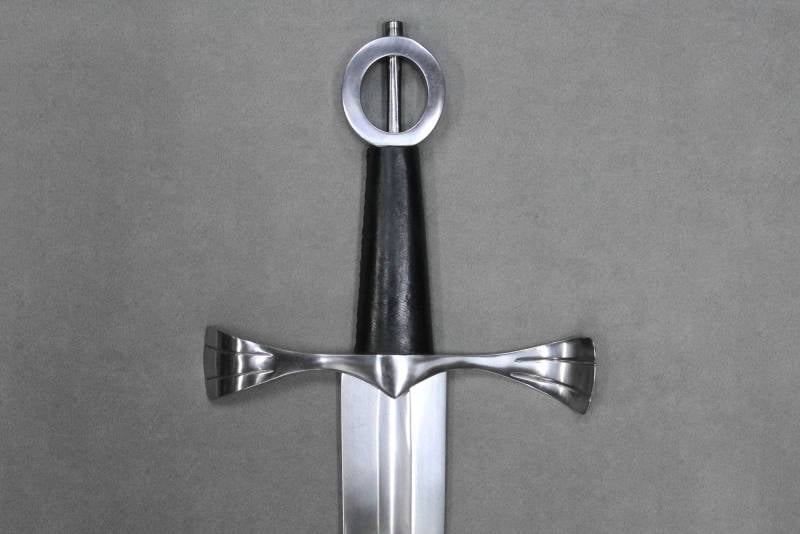
Information